BUS501: Good Harvest Business Analytics and Statistics Research Report
VerifiedAdded on 2020/02/19
|19
|3672
|28
Report
AI Summary
This research report, focused on Good Harvest, a business specializing in organic food, conducts a thorough analysis of its business performance using statistical methods. The study addresses key research questions, including the top and worst-selling products, differences in payment methods (cash, credit, Visa, and MasterCard), the impact of product location on sales, and variations in sales and gross profits across different months and seasons. The report employs descriptive statistics, normality tests, ANOVA, and t-tests to derive insights. Key findings reveal significant differences in sales between payment methods, variations in sales performance based on product location, and seasonal influences on sales. The report provides detailed statistical tables and figures, along with a discussion of the results, and offers recommendations to improve revenue and business strategies. The report covers a range of products and analyzes data to provide recommendations to the CEO for business improvement.
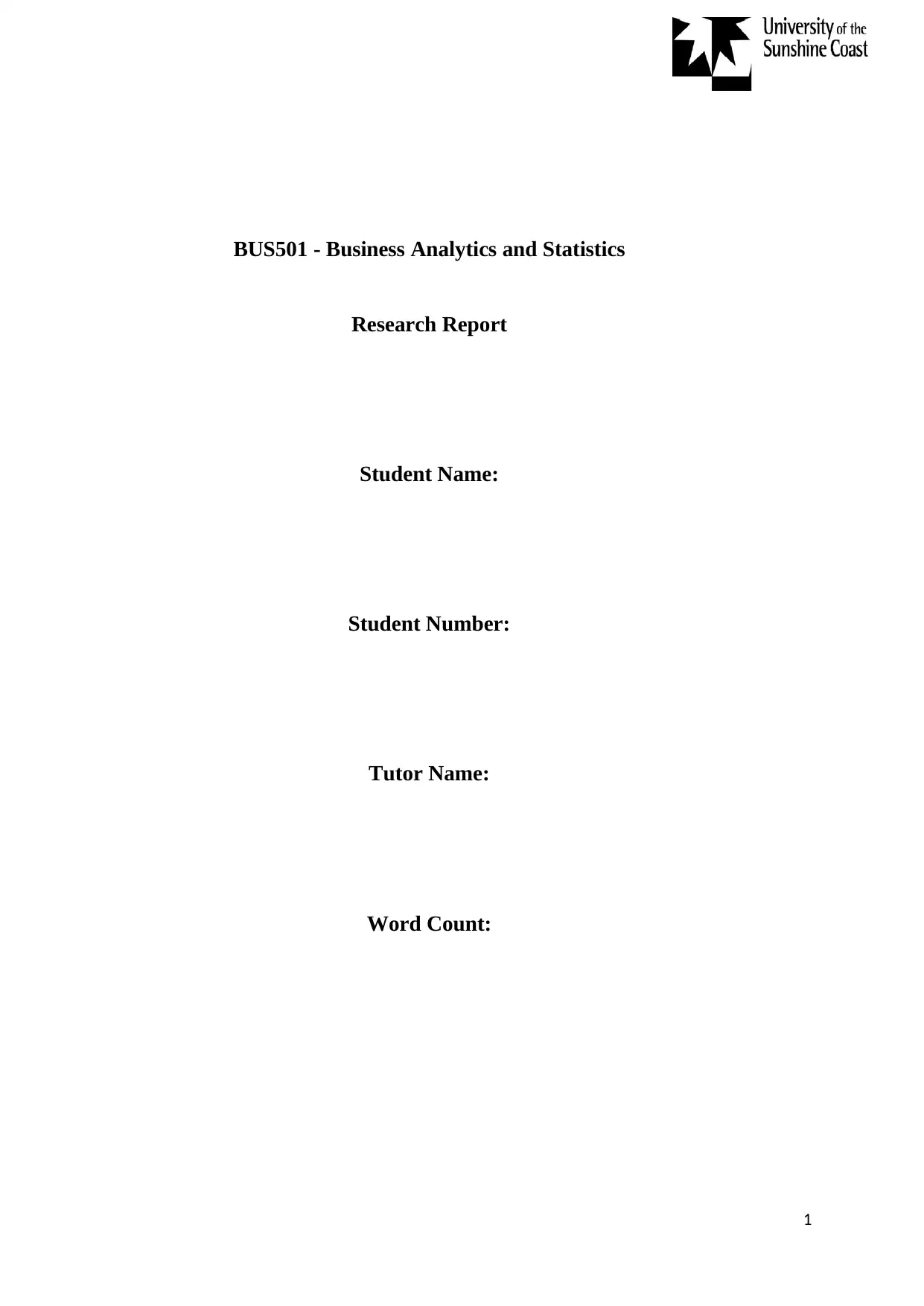
BUS501 - Business Analytics and Statistics
Research Report
Student Name:
Student Number:
Tutor Name:
Word Count:
1
Research Report
Student Name:
Student Number:
Tutor Name:
Word Count:
1
Paraphrase This Document
Need a fresh take? Get an instant paraphrase of this document with our AI Paraphraser
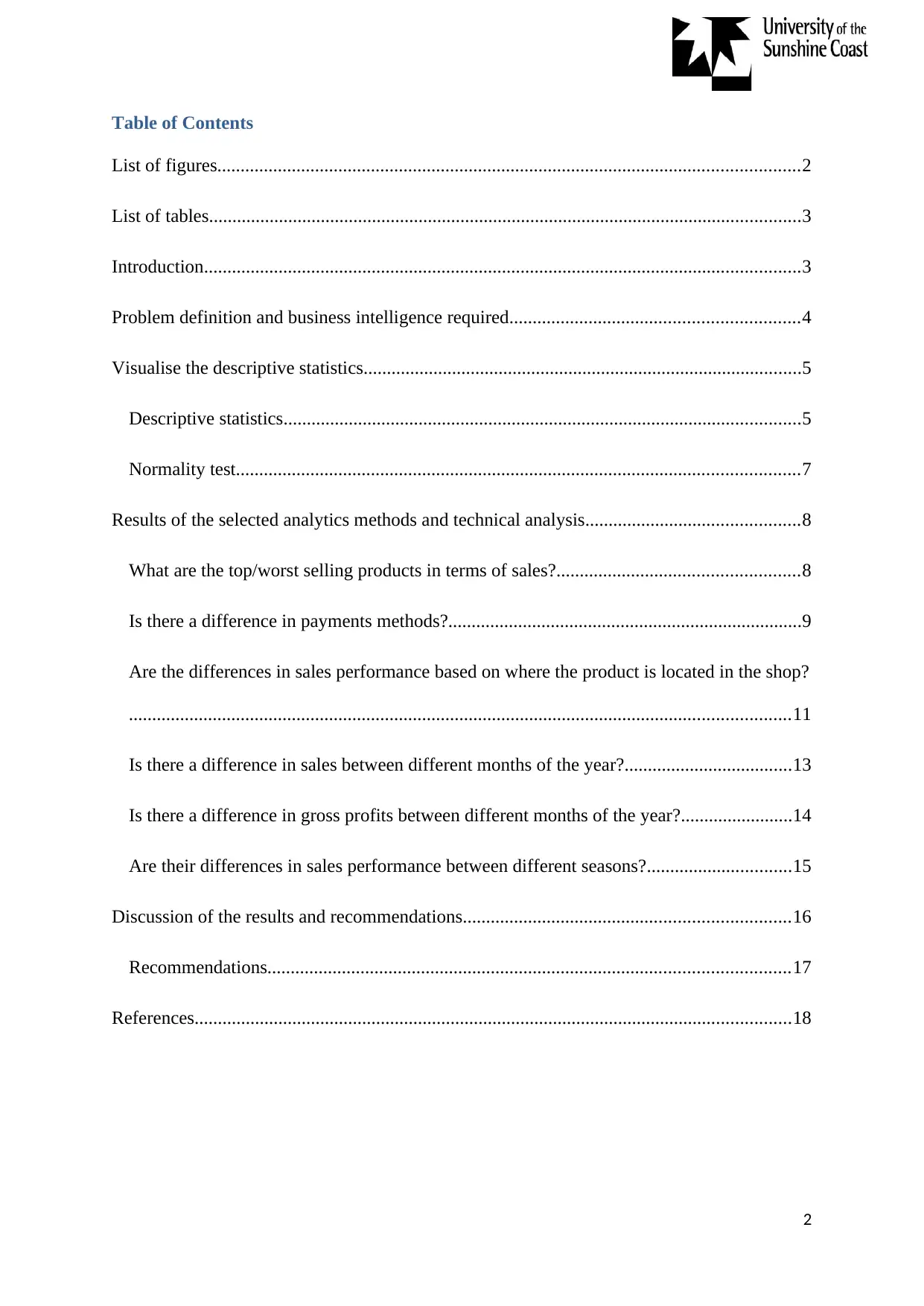
Table of Contents
List of figures.............................................................................................................................2
List of tables...............................................................................................................................3
Introduction................................................................................................................................3
Problem definition and business intelligence required..............................................................4
Visualise the descriptive statistics..............................................................................................5
Descriptive statistics...............................................................................................................5
Normality test.........................................................................................................................7
Results of the selected analytics methods and technical analysis..............................................8
What are the top/worst selling products in terms of sales?....................................................8
Is there a difference in payments methods?............................................................................9
Are the differences in sales performance based on where the product is located in the shop?
..............................................................................................................................................11
Is there a difference in sales between different months of the year?....................................13
Is there a difference in gross profits between different months of the year?........................14
Are their differences in sales performance between different seasons?...............................15
Discussion of the results and recommendations......................................................................16
Recommendations................................................................................................................17
References................................................................................................................................18
2
List of figures.............................................................................................................................2
List of tables...............................................................................................................................3
Introduction................................................................................................................................3
Problem definition and business intelligence required..............................................................4
Visualise the descriptive statistics..............................................................................................5
Descriptive statistics...............................................................................................................5
Normality test.........................................................................................................................7
Results of the selected analytics methods and technical analysis..............................................8
What are the top/worst selling products in terms of sales?....................................................8
Is there a difference in payments methods?............................................................................9
Are the differences in sales performance based on where the product is located in the shop?
..............................................................................................................................................11
Is there a difference in sales between different months of the year?....................................13
Is there a difference in gross profits between different months of the year?........................14
Are their differences in sales performance between different seasons?...............................15
Discussion of the results and recommendations......................................................................16
Recommendations................................................................................................................17
References................................................................................................................................18
2
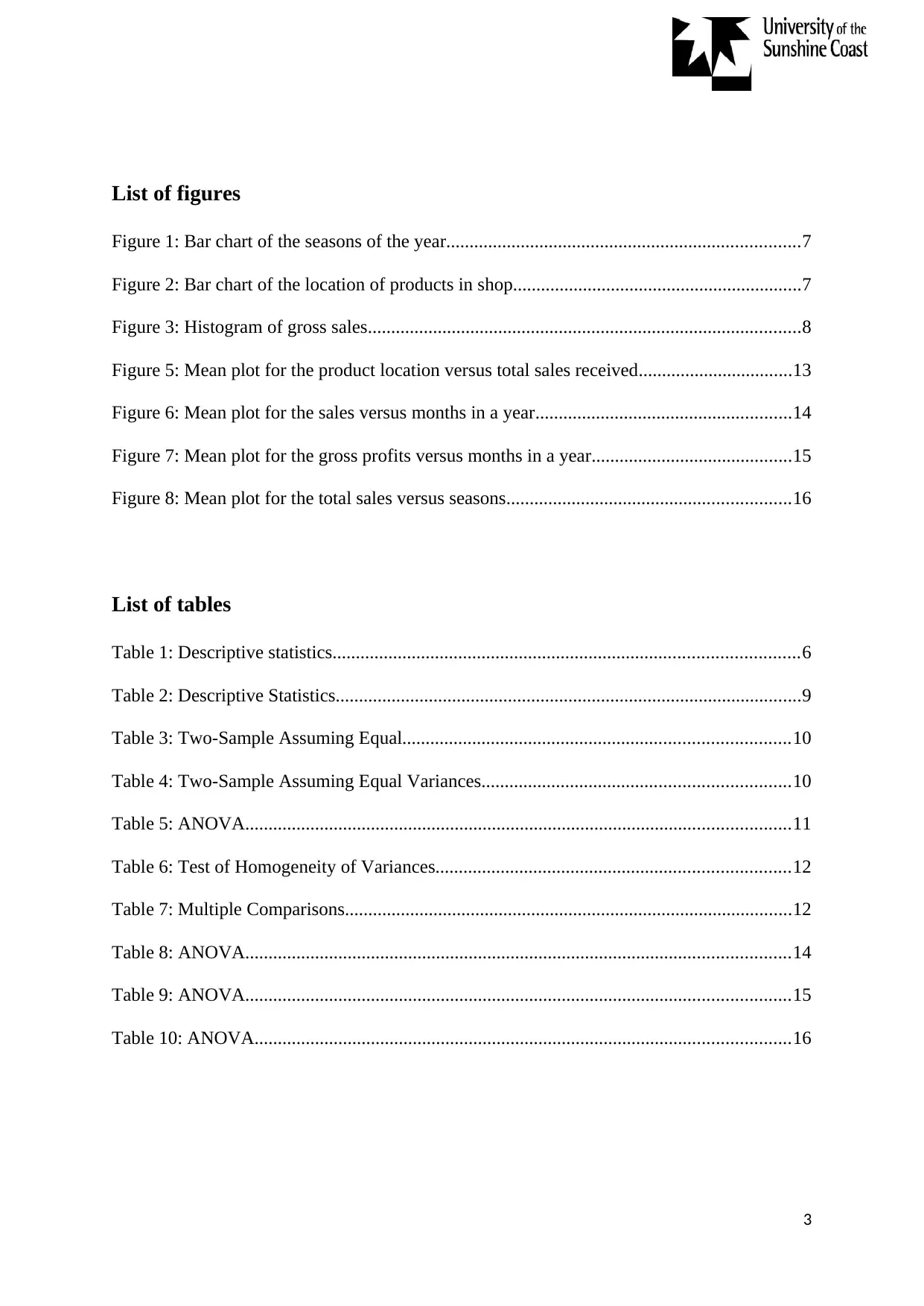
List of figures
Figure 1: Bar chart of the seasons of the year............................................................................7
Figure 2: Bar chart of the location of products in shop..............................................................7
Figure 3: Histogram of gross sales.............................................................................................8
Figure 5: Mean plot for the product location versus total sales received.................................13
Figure 6: Mean plot for the sales versus months in a year.......................................................14
Figure 7: Mean plot for the gross profits versus months in a year...........................................15
Figure 8: Mean plot for the total sales versus seasons.............................................................16
List of tables
Table 1: Descriptive statistics....................................................................................................6
Table 2: Descriptive Statistics....................................................................................................9
Table 3: Two-Sample Assuming Equal...................................................................................10
Table 4: Two-Sample Assuming Equal Variances..................................................................10
Table 5: ANOVA.....................................................................................................................11
Table 6: Test of Homogeneity of Variances............................................................................12
Table 7: Multiple Comparisons................................................................................................12
Table 8: ANOVA.....................................................................................................................14
Table 9: ANOVA.....................................................................................................................15
Table 10: ANOVA...................................................................................................................16
3
Figure 1: Bar chart of the seasons of the year............................................................................7
Figure 2: Bar chart of the location of products in shop..............................................................7
Figure 3: Histogram of gross sales.............................................................................................8
Figure 5: Mean plot for the product location versus total sales received.................................13
Figure 6: Mean plot for the sales versus months in a year.......................................................14
Figure 7: Mean plot for the gross profits versus months in a year...........................................15
Figure 8: Mean plot for the total sales versus seasons.............................................................16
List of tables
Table 1: Descriptive statistics....................................................................................................6
Table 2: Descriptive Statistics....................................................................................................9
Table 3: Two-Sample Assuming Equal...................................................................................10
Table 4: Two-Sample Assuming Equal Variances..................................................................10
Table 5: ANOVA.....................................................................................................................11
Table 6: Test of Homogeneity of Variances............................................................................12
Table 7: Multiple Comparisons................................................................................................12
Table 8: ANOVA.....................................................................................................................14
Table 9: ANOVA.....................................................................................................................15
Table 10: ANOVA...................................................................................................................16
3
⊘ This is a preview!⊘
Do you want full access?
Subscribe today to unlock all pages.

Trusted by 1+ million students worldwide
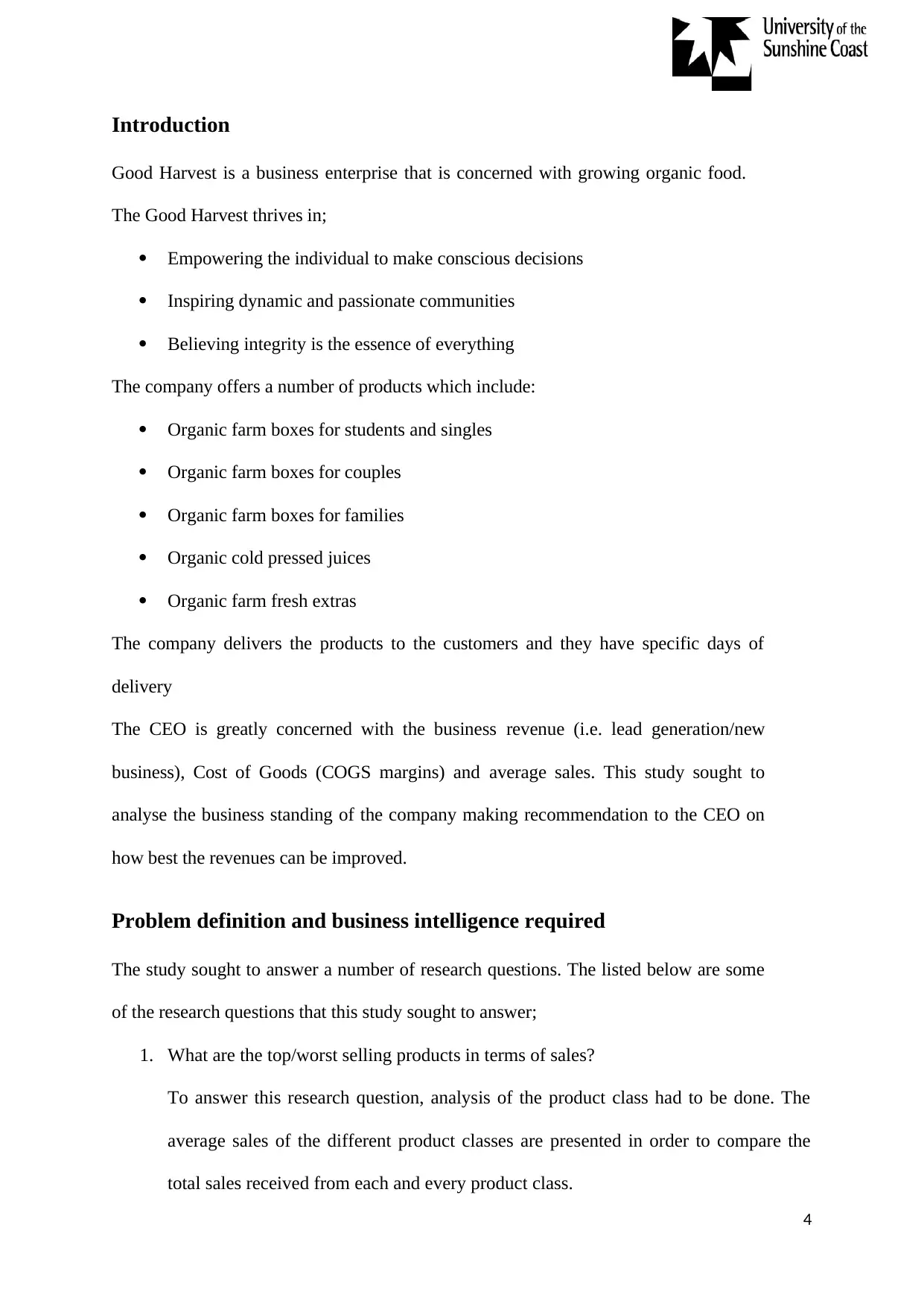
Introduction
Good Harvest is a business enterprise that is concerned with growing organic food.
The Good Harvest thrives in;
Empowering the individual to make conscious decisions
Inspiring dynamic and passionate communities
Believing integrity is the essence of everything
The company offers a number of products which include:
Organic farm boxes for students and singles
Organic farm boxes for couples
Organic farm boxes for families
Organic cold pressed juices
Organic farm fresh extras
The company delivers the products to the customers and they have specific days of
delivery
The CEO is greatly concerned with the business revenue (i.e. lead generation/new
business), Cost of Goods (COGS margins) and average sales. This study sought to
analyse the business standing of the company making recommendation to the CEO on
how best the revenues can be improved.
Problem definition and business intelligence required
The study sought to answer a number of research questions. The listed below are some
of the research questions that this study sought to answer;
1. What are the top/worst selling products in terms of sales?
To answer this research question, analysis of the product class had to be done. The
average sales of the different product classes are presented in order to compare the
total sales received from each and every product class.
4
Good Harvest is a business enterprise that is concerned with growing organic food.
The Good Harvest thrives in;
Empowering the individual to make conscious decisions
Inspiring dynamic and passionate communities
Believing integrity is the essence of everything
The company offers a number of products which include:
Organic farm boxes for students and singles
Organic farm boxes for couples
Organic farm boxes for families
Organic cold pressed juices
Organic farm fresh extras
The company delivers the products to the customers and they have specific days of
delivery
The CEO is greatly concerned with the business revenue (i.e. lead generation/new
business), Cost of Goods (COGS margins) and average sales. This study sought to
analyse the business standing of the company making recommendation to the CEO on
how best the revenues can be improved.
Problem definition and business intelligence required
The study sought to answer a number of research questions. The listed below are some
of the research questions that this study sought to answer;
1. What are the top/worst selling products in terms of sales?
To answer this research question, analysis of the product class had to be done. The
average sales of the different product classes are presented in order to compare the
total sales received from each and every product class.
4
Paraphrase This Document
Need a fresh take? Get an instant paraphrase of this document with our AI Paraphraser

2. Is there a difference in payments methods?
Four different payments methods are provided, namely; cash, credit, visa and
MasterCard payment options. To answer the research question, two independent t-
tests will be applied. An independent-samples t-test, refers to an inferential statistical
test that is used to test whether there is a statistically significant difference between
the means of two unrelated groups. This approach is used analyze the differences two
independent group means and their associated procedures (Derrick, Toher, & White,
2017). So cash and credit will be compared together while Visa and MasterCard will
also be compared together hence the need for two independent t-tests.
3. Are the differences in sales performance based on where the product is located in the
shop? How does this effect both profits and revenue?
The third research question that this study sought to answer was whether there are
differences in sales performance based on where the product is located in the shop.
This question will be answered using ANOVA test. ANOVA test is useful when it
comes to comparing (testing) three or more means (groups or variables) for statistical
significance (Hinkelmann & Kempthorne, 2010). Since there are more than 3
locations (factors), ANOVA would be an ideal methodology to test for the differences
in sales performance.
4. Is there a difference in sales and gross profits between different months of the year?
This is another research question that will be answered using ANOVA. There are 12
months in a year and as such, we will try to verify whether there is variation in the
mean sales and mean gross profits made in different months. Since ANOVA tests
whether the means for three or more factors are vary statistically, the test (ANOVA)
will be ideal for answering this research question (Gelman, 2005).
5. Are their differences in sales performance between different seasons?
5
Four different payments methods are provided, namely; cash, credit, visa and
MasterCard payment options. To answer the research question, two independent t-
tests will be applied. An independent-samples t-test, refers to an inferential statistical
test that is used to test whether there is a statistically significant difference between
the means of two unrelated groups. This approach is used analyze the differences two
independent group means and their associated procedures (Derrick, Toher, & White,
2017). So cash and credit will be compared together while Visa and MasterCard will
also be compared together hence the need for two independent t-tests.
3. Are the differences in sales performance based on where the product is located in the
shop? How does this effect both profits and revenue?
The third research question that this study sought to answer was whether there are
differences in sales performance based on where the product is located in the shop.
This question will be answered using ANOVA test. ANOVA test is useful when it
comes to comparing (testing) three or more means (groups or variables) for statistical
significance (Hinkelmann & Kempthorne, 2010). Since there are more than 3
locations (factors), ANOVA would be an ideal methodology to test for the differences
in sales performance.
4. Is there a difference in sales and gross profits between different months of the year?
This is another research question that will be answered using ANOVA. There are 12
months in a year and as such, we will try to verify whether there is variation in the
mean sales and mean gross profits made in different months. Since ANOVA tests
whether the means for three or more factors are vary statistically, the test (ANOVA)
will be ideal for answering this research question (Gelman, 2005).
5. Are their differences in sales performance between different seasons?
5
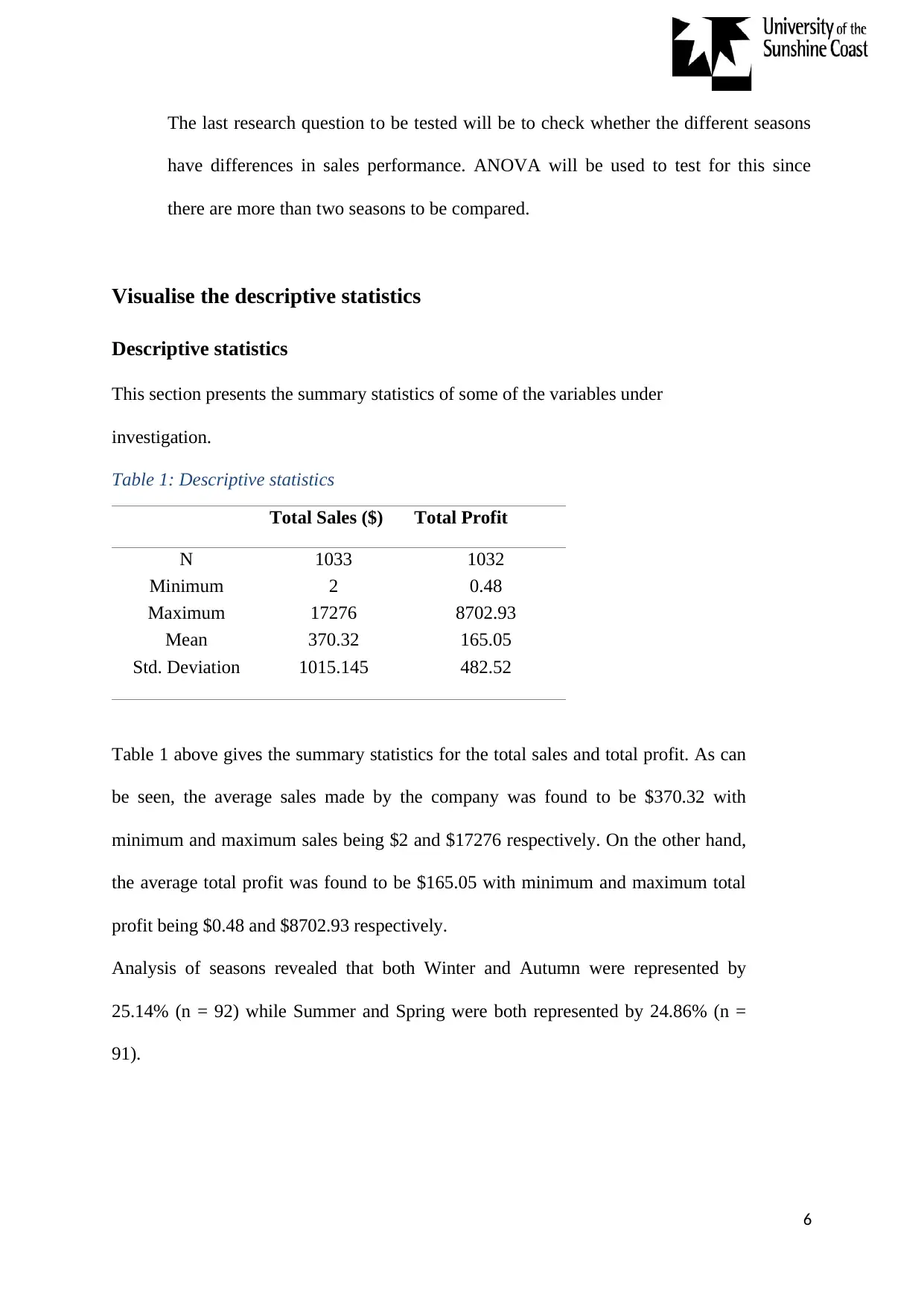
The last research question to be tested will be to check whether the different seasons
have differences in sales performance. ANOVA will be used to test for this since
there are more than two seasons to be compared.
Visualise the descriptive statistics
Descriptive statistics
This section presents the summary statistics of some of the variables under
investigation.
Table 1: Descriptive statistics
Total Sales ($) Total Profit
N 1033 1032
Minimum 2 0.48
Maximum 17276 8702.93
Mean 370.32 165.05
Std. Deviation 1015.145 482.52
Table 1 above gives the summary statistics for the total sales and total profit. As can
be seen, the average sales made by the company was found to be $370.32 with
minimum and maximum sales being $2 and $17276 respectively. On the other hand,
the average total profit was found to be $165.05 with minimum and maximum total
profit being $0.48 and $8702.93 respectively.
Analysis of seasons revealed that both Winter and Autumn were represented by
25.14% (n = 92) while Summer and Spring were both represented by 24.86% (n =
91).
6
have differences in sales performance. ANOVA will be used to test for this since
there are more than two seasons to be compared.
Visualise the descriptive statistics
Descriptive statistics
This section presents the summary statistics of some of the variables under
investigation.
Table 1: Descriptive statistics
Total Sales ($) Total Profit
N 1033 1032
Minimum 2 0.48
Maximum 17276 8702.93
Mean 370.32 165.05
Std. Deviation 1015.145 482.52
Table 1 above gives the summary statistics for the total sales and total profit. As can
be seen, the average sales made by the company was found to be $370.32 with
minimum and maximum sales being $2 and $17276 respectively. On the other hand,
the average total profit was found to be $165.05 with minimum and maximum total
profit being $0.48 and $8702.93 respectively.
Analysis of seasons revealed that both Winter and Autumn were represented by
25.14% (n = 92) while Summer and Spring were both represented by 24.86% (n =
91).
6
⊘ This is a preview!⊘
Do you want full access?
Subscribe today to unlock all pages.

Trusted by 1+ million students worldwide
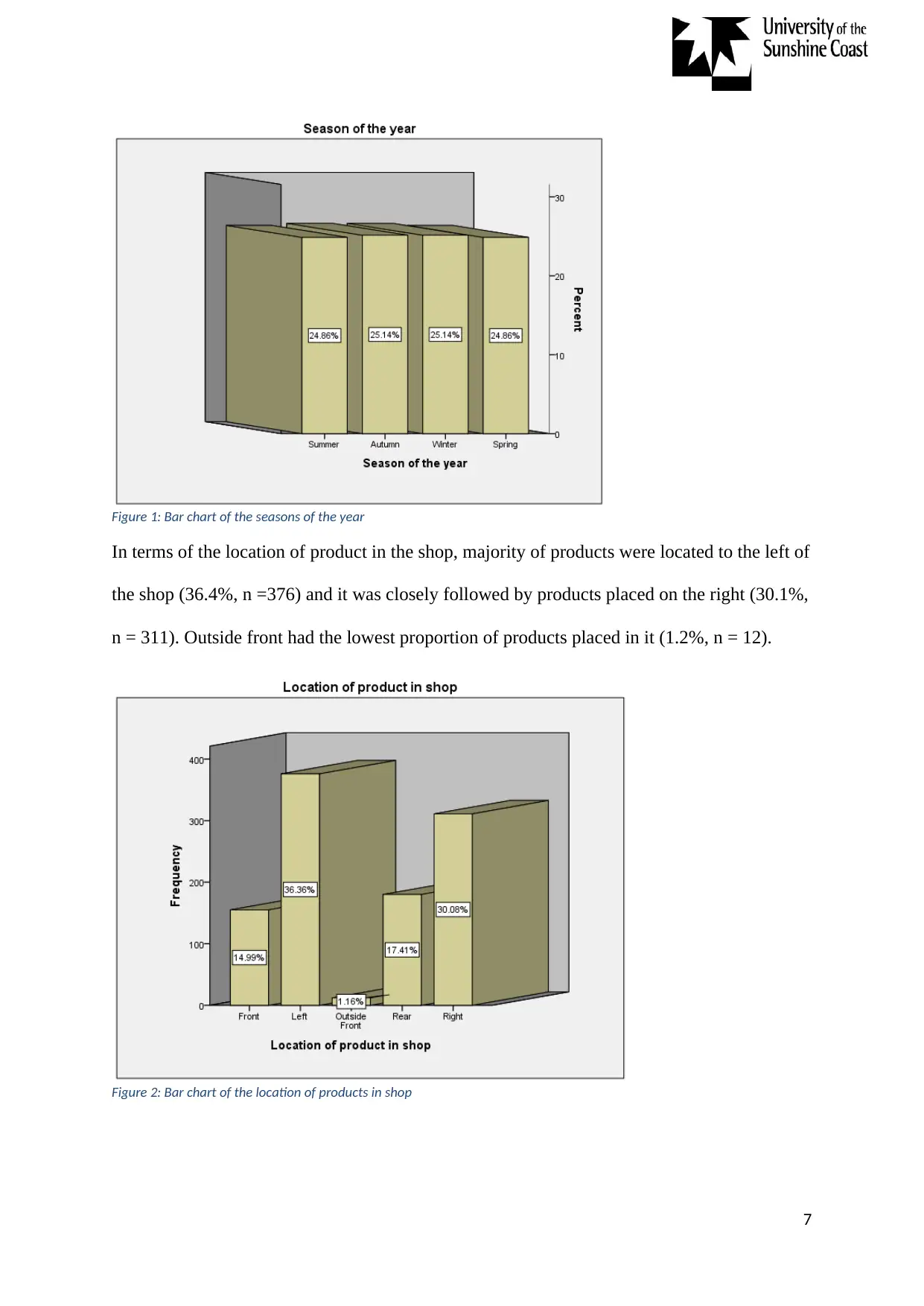
Figure 1: Bar chart of the seasons of the year
In terms of the location of product in the shop, majority of products were located to the left of
the shop (36.4%, n =376) and it was closely followed by products placed on the right (30.1%,
n = 311). Outside front had the lowest proportion of products placed in it (1.2%, n = 12).
Figure 2: Bar chart of the location of products in shop
7
In terms of the location of product in the shop, majority of products were located to the left of
the shop (36.4%, n =376) and it was closely followed by products placed on the right (30.1%,
n = 311). Outside front had the lowest proportion of products placed in it (1.2%, n = 12).
Figure 2: Bar chart of the location of products in shop
7
Paraphrase This Document
Need a fresh take? Get an instant paraphrase of this document with our AI Paraphraser
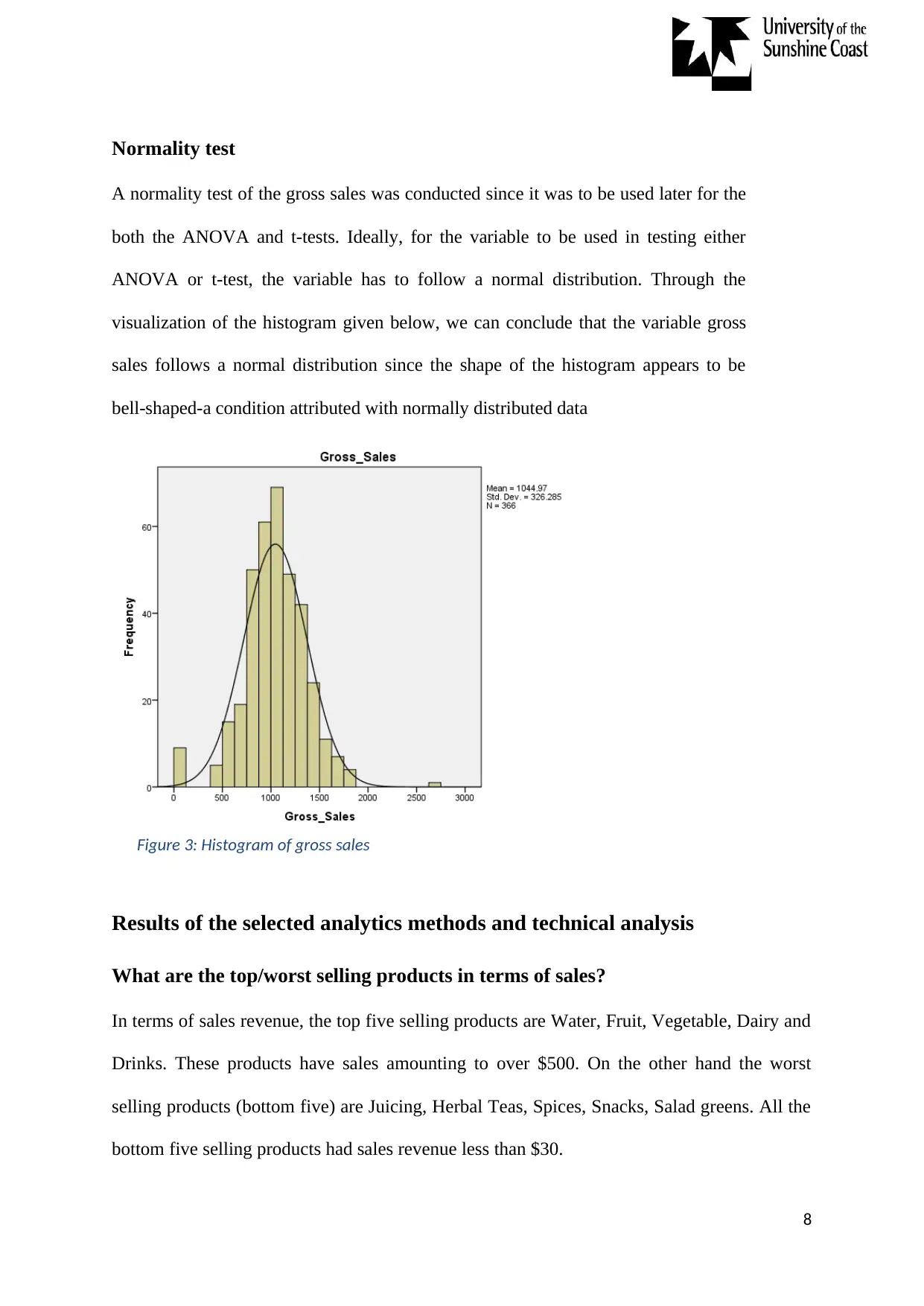
Normality test
A normality test of the gross sales was conducted since it was to be used later for the
both the ANOVA and t-tests. Ideally, for the variable to be used in testing either
ANOVA or t-test, the variable has to follow a normal distribution. Through the
visualization of the histogram given below, we can conclude that the variable gross
sales follows a normal distribution since the shape of the histogram appears to be
bell-shaped-a condition attributed with normally distributed data
Figure 3: Histogram of gross sales
Results of the selected analytics methods and technical analysis
What are the top/worst selling products in terms of sales?
In terms of sales revenue, the top five selling products are Water, Fruit, Vegetable, Dairy and
Drinks. These products have sales amounting to over $500. On the other hand the worst
selling products (bottom five) are Juicing, Herbal Teas, Spices, Snacks, Salad greens. All the
bottom five selling products had sales revenue less than $30.
8
A normality test of the gross sales was conducted since it was to be used later for the
both the ANOVA and t-tests. Ideally, for the variable to be used in testing either
ANOVA or t-test, the variable has to follow a normal distribution. Through the
visualization of the histogram given below, we can conclude that the variable gross
sales follows a normal distribution since the shape of the histogram appears to be
bell-shaped-a condition attributed with normally distributed data
Figure 3: Histogram of gross sales
Results of the selected analytics methods and technical analysis
What are the top/worst selling products in terms of sales?
In terms of sales revenue, the top five selling products are Water, Fruit, Vegetable, Dairy and
Drinks. These products have sales amounting to over $500. On the other hand the worst
selling products (bottom five) are Juicing, Herbal Teas, Spices, Snacks, Salad greens. All the
bottom five selling products had sales revenue less than $30.
8
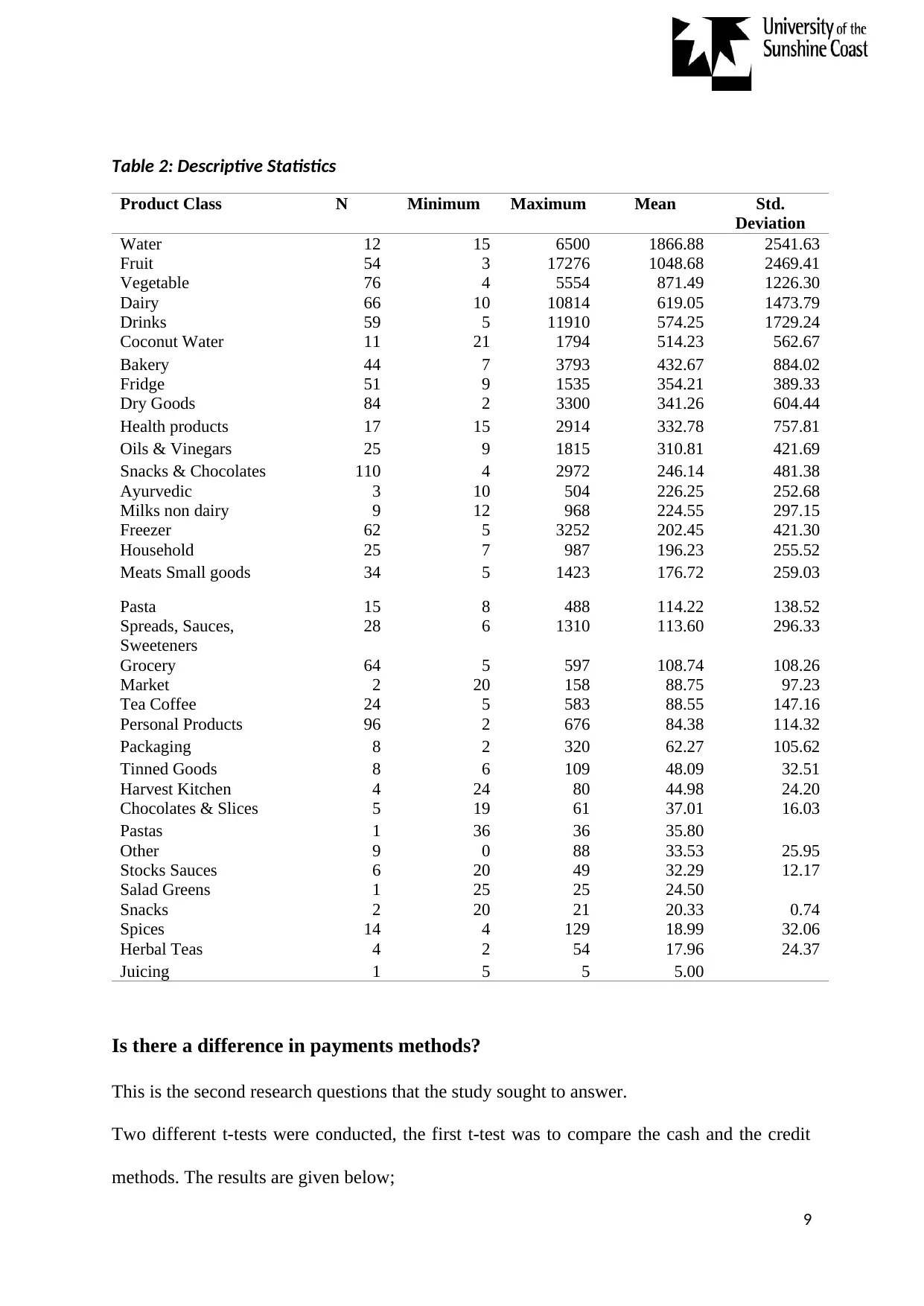
Table 2: Descriptive Statistics
Product Class N Minimum Maximum Mean Std.
Deviation
Water 12 15 6500 1866.88 2541.63
Fruit 54 3 17276 1048.68 2469.41
Vegetable 76 4 5554 871.49 1226.30
Dairy 66 10 10814 619.05 1473.79
Drinks 59 5 11910 574.25 1729.24
Coconut Water 11 21 1794 514.23 562.67
Bakery 44 7 3793 432.67 884.02
Fridge 51 9 1535 354.21 389.33
Dry Goods 84 2 3300 341.26 604.44
Health products 17 15 2914 332.78 757.81
Oils & Vinegars 25 9 1815 310.81 421.69
Snacks & Chocolates 110 4 2972 246.14 481.38
Ayurvedic 3 10 504 226.25 252.68
Milks non dairy 9 12 968 224.55 297.15
Freezer 62 5 3252 202.45 421.30
Household 25 7 987 196.23 255.52
Meats Small goods 34 5 1423 176.72 259.03
Pasta 15 8 488 114.22 138.52
Spreads, Sauces,
Sweeteners
28 6 1310 113.60 296.33
Grocery 64 5 597 108.74 108.26
Market 2 20 158 88.75 97.23
Tea Coffee 24 5 583 88.55 147.16
Personal Products 96 2 676 84.38 114.32
Packaging 8 2 320 62.27 105.62
Tinned Goods 8 6 109 48.09 32.51
Harvest Kitchen 4 24 80 44.98 24.20
Chocolates & Slices 5 19 61 37.01 16.03
Pastas 1 36 36 35.80
Other 9 0 88 33.53 25.95
Stocks Sauces 6 20 49 32.29 12.17
Salad Greens 1 25 25 24.50
Snacks 2 20 21 20.33 0.74
Spices 14 4 129 18.99 32.06
Herbal Teas 4 2 54 17.96 24.37
Juicing 1 5 5 5.00
Is there a difference in payments methods?
This is the second research questions that the study sought to answer.
Two different t-tests were conducted, the first t-test was to compare the cash and the credit
methods. The results are given below;
9
Product Class N Minimum Maximum Mean Std.
Deviation
Water 12 15 6500 1866.88 2541.63
Fruit 54 3 17276 1048.68 2469.41
Vegetable 76 4 5554 871.49 1226.30
Dairy 66 10 10814 619.05 1473.79
Drinks 59 5 11910 574.25 1729.24
Coconut Water 11 21 1794 514.23 562.67
Bakery 44 7 3793 432.67 884.02
Fridge 51 9 1535 354.21 389.33
Dry Goods 84 2 3300 341.26 604.44
Health products 17 15 2914 332.78 757.81
Oils & Vinegars 25 9 1815 310.81 421.69
Snacks & Chocolates 110 4 2972 246.14 481.38
Ayurvedic 3 10 504 226.25 252.68
Milks non dairy 9 12 968 224.55 297.15
Freezer 62 5 3252 202.45 421.30
Household 25 7 987 196.23 255.52
Meats Small goods 34 5 1423 176.72 259.03
Pasta 15 8 488 114.22 138.52
Spreads, Sauces,
Sweeteners
28 6 1310 113.60 296.33
Grocery 64 5 597 108.74 108.26
Market 2 20 158 88.75 97.23
Tea Coffee 24 5 583 88.55 147.16
Personal Products 96 2 676 84.38 114.32
Packaging 8 2 320 62.27 105.62
Tinned Goods 8 6 109 48.09 32.51
Harvest Kitchen 4 24 80 44.98 24.20
Chocolates & Slices 5 19 61 37.01 16.03
Pastas 1 36 36 35.80
Other 9 0 88 33.53 25.95
Stocks Sauces 6 20 49 32.29 12.17
Salad Greens 1 25 25 24.50
Snacks 2 20 21 20.33 0.74
Spices 14 4 129 18.99 32.06
Herbal Teas 4 2 54 17.96 24.37
Juicing 1 5 5 5.00
Is there a difference in payments methods?
This is the second research questions that the study sought to answer.
Two different t-tests were conducted, the first t-test was to compare the cash and the credit
methods. The results are given below;
9
⊘ This is a preview!⊘
Do you want full access?
Subscribe today to unlock all pages.

Trusted by 1+ million students worldwide

Table 3: Two-Sample Assuming Equal
Variances
Cash Credit
Mean 404.2923 584.8115
Variance 23608.25 52380.18
Observations 366 366
Pooled Variance 37994.21
Hypothesized Mean
Difference 0
df 730
t Stat -12.5282
P(T<=t) one-tail 4.69E-33
t Critical one-tail 1.646944
P(T<=t) two-tail 9.37E-33
t Critical two-tail 1.963219
An independent samples t-test was done to compare the mean total cash received from either
cash or credit payments. Results showed that the cash payments (M = 404.29, SD = 153.65,
N = 366) had significant difference in terms of the total cash received when compared to the
credit payments (M = 584.81, SD = 228.87, N = 366), t (730) = -12.53, p < .05, two-tailed.
The difference of 180.52 showed a significant difference. Essentially results showed that
credit payment method attracts more total cash received as compared to the cash payment
methods.
Next, we compared the total cash received through the Visa payment method and the
MasterCard payment method. An independent t-test was performed to compare the mean
total cash received for the two payments methods. Results are in the table below;
Table 4: Two-Sample Assuming Equal Variances
Visa
MasterCar
d
Mean 579.5983 152.5472
Variance 48734.1 12000.98
Observations 351 53
Pooled Variance 43982.56
Hypothesized Mean
Difference 0
10
Variances
Cash Credit
Mean 404.2923 584.8115
Variance 23608.25 52380.18
Observations 366 366
Pooled Variance 37994.21
Hypothesized Mean
Difference 0
df 730
t Stat -12.5282
P(T<=t) one-tail 4.69E-33
t Critical one-tail 1.646944
P(T<=t) two-tail 9.37E-33
t Critical two-tail 1.963219
An independent samples t-test was done to compare the mean total cash received from either
cash or credit payments. Results showed that the cash payments (M = 404.29, SD = 153.65,
N = 366) had significant difference in terms of the total cash received when compared to the
credit payments (M = 584.81, SD = 228.87, N = 366), t (730) = -12.53, p < .05, two-tailed.
The difference of 180.52 showed a significant difference. Essentially results showed that
credit payment method attracts more total cash received as compared to the cash payment
methods.
Next, we compared the total cash received through the Visa payment method and the
MasterCard payment method. An independent t-test was performed to compare the mean
total cash received for the two payments methods. Results are in the table below;
Table 4: Two-Sample Assuming Equal Variances
Visa
MasterCar
d
Mean 579.5983 152.5472
Variance 48734.1 12000.98
Observations 351 53
Pooled Variance 43982.56
Hypothesized Mean
Difference 0
10
Paraphrase This Document
Need a fresh take? Get an instant paraphrase of this document with our AI Paraphraser
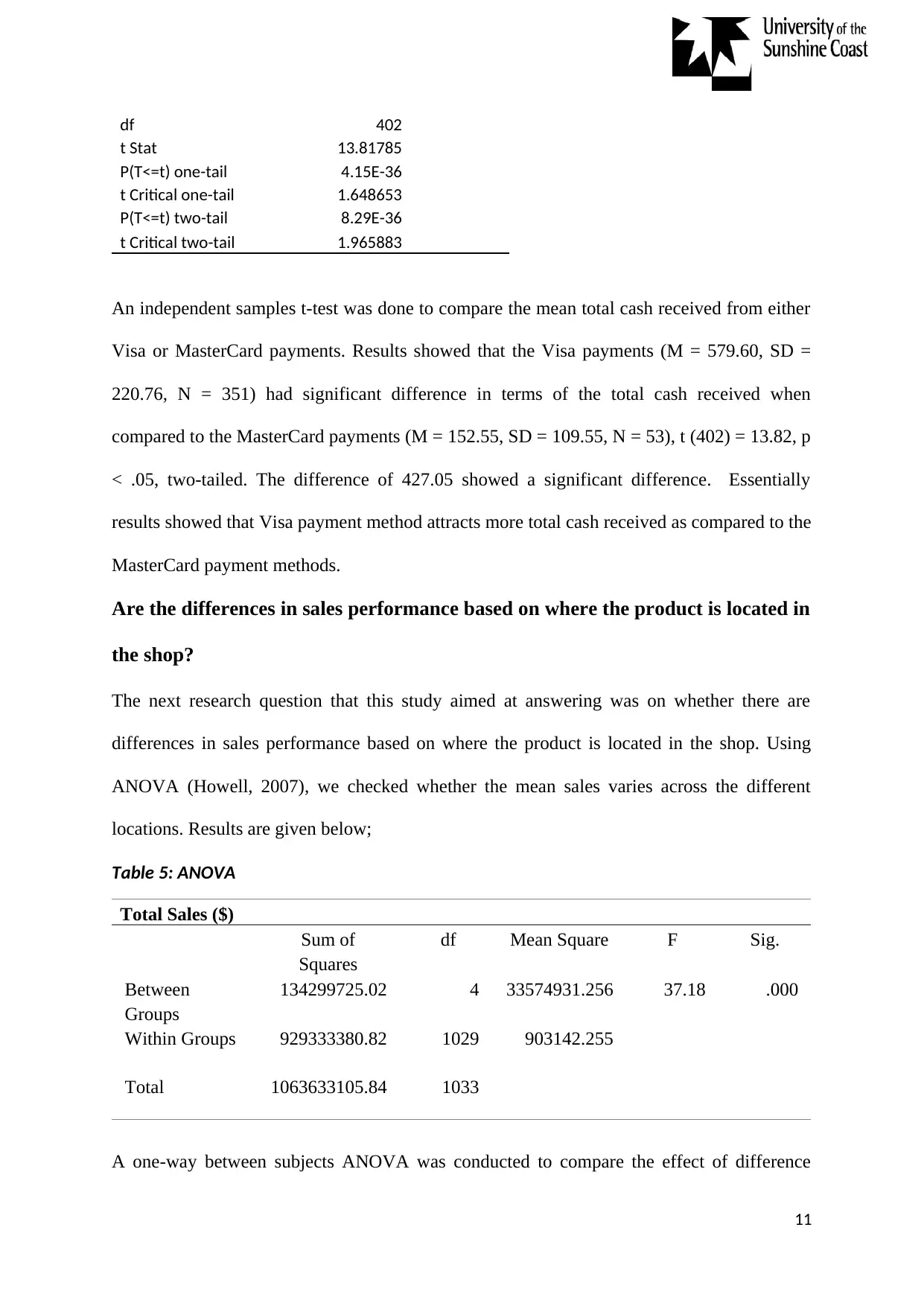
df 402
t Stat 13.81785
P(T<=t) one-tail 4.15E-36
t Critical one-tail 1.648653
P(T<=t) two-tail 8.29E-36
t Critical two-tail 1.965883
An independent samples t-test was done to compare the mean total cash received from either
Visa or MasterCard payments. Results showed that the Visa payments (M = 579.60, SD =
220.76, N = 351) had significant difference in terms of the total cash received when
compared to the MasterCard payments (M = 152.55, SD = 109.55, N = 53), t (402) = 13.82, p
< .05, two-tailed. The difference of 427.05 showed a significant difference. Essentially
results showed that Visa payment method attracts more total cash received as compared to the
MasterCard payment methods.
Are the differences in sales performance based on where the product is located in
the shop?
The next research question that this study aimed at answering was on whether there are
differences in sales performance based on where the product is located in the shop. Using
ANOVA (Howell, 2007), we checked whether the mean sales varies across the different
locations. Results are given below;
Table 5: ANOVA
Total Sales ($)
Sum of
Squares
df Mean Square F Sig.
Between
Groups
134299725.02 4 33574931.256 37.18 .000
Within Groups 929333380.82 1029 903142.255
Total 1063633105.84 1033
A one-way between subjects ANOVA was conducted to compare the effect of difference
11
t Stat 13.81785
P(T<=t) one-tail 4.15E-36
t Critical one-tail 1.648653
P(T<=t) two-tail 8.29E-36
t Critical two-tail 1.965883
An independent samples t-test was done to compare the mean total cash received from either
Visa or MasterCard payments. Results showed that the Visa payments (M = 579.60, SD =
220.76, N = 351) had significant difference in terms of the total cash received when
compared to the MasterCard payments (M = 152.55, SD = 109.55, N = 53), t (402) = 13.82, p
< .05, two-tailed. The difference of 427.05 showed a significant difference. Essentially
results showed that Visa payment method attracts more total cash received as compared to the
MasterCard payment methods.
Are the differences in sales performance based on where the product is located in
the shop?
The next research question that this study aimed at answering was on whether there are
differences in sales performance based on where the product is located in the shop. Using
ANOVA (Howell, 2007), we checked whether the mean sales varies across the different
locations. Results are given below;
Table 5: ANOVA
Total Sales ($)
Sum of
Squares
df Mean Square F Sig.
Between
Groups
134299725.02 4 33574931.256 37.18 .000
Within Groups 929333380.82 1029 903142.255
Total 1063633105.84 1033
A one-way between subjects ANOVA was conducted to compare the effect of difference
11

locations of the product on the sales (Gelman, 2005). There was a significant effect of
location where the product is located on the total sales at the p<.05 level for the five
conditions [F(4, 1029) = 37.18, p = 0.000].
Table 6: Test of Homogeneity of Variances
Total Sales ($)
Levene Statistic df1 df2 Sig.
47.870 4 1029 .000
Test of homogeneity of variances showed that the groups we are comparing do not similar
population variances. For this reason, post hoc analysis employed would be the one that does
not assume equal variances. It is for this reason that Games-Howell was used.
Table 7: Multiple Comparisons
Dependent Variable: Total Sales ($)
Games-Howell
(I)
Location
of product
in shop
(J) Location of
product in
shop
Mean
Difference
(I-J)
Std. Error Sig. 95% Confidence Interval
Lower
Bound
Upper
Bound
Front Left 357.512* 117.700 .023 32.86 682.17
Outside Front -2808.054 1367.254 .303 -7218.81 1602.70
Rear 40.243 140.538 .999 -345.63 426.11
Right 336.423* 119.784 .043 6.27 666.58
Left Front -357.512* 117.700 .023 -682.17 -32.86
Outside Front -3165.566 1362.538 .208 -7571.64 1240.50
Rear -317.269* 82.914 .002 -545.45 -89.09
Right -21.089 38.365 .982 -126.07 83.90
Outside
Front
Front 2808.054 1367.254 .303 -1602.70 7218.81
Left 3165.566 1362.538 .208 -1240.50 7571.64
Rear 2848.297 1364.700 .290 -1559.90 7256.50
Right 3144.477 1362.719 .213 -1261.77 7550.73
Rear Front -40.243 140.538 .999 -426.11 345.63
Left 317.269* 82.914 .002 89.09 545.45
Outside Front -2848.297 1364.700 .290 -7256.50 1559.90
Right 296.181* 85.846 .006 60.19 532.18
Right Front -336.423* 119.784 .043 -666.58 -6.27
12
location where the product is located on the total sales at the p<.05 level for the five
conditions [F(4, 1029) = 37.18, p = 0.000].
Table 6: Test of Homogeneity of Variances
Total Sales ($)
Levene Statistic df1 df2 Sig.
47.870 4 1029 .000
Test of homogeneity of variances showed that the groups we are comparing do not similar
population variances. For this reason, post hoc analysis employed would be the one that does
not assume equal variances. It is for this reason that Games-Howell was used.
Table 7: Multiple Comparisons
Dependent Variable: Total Sales ($)
Games-Howell
(I)
Location
of product
in shop
(J) Location of
product in
shop
Mean
Difference
(I-J)
Std. Error Sig. 95% Confidence Interval
Lower
Bound
Upper
Bound
Front Left 357.512* 117.700 .023 32.86 682.17
Outside Front -2808.054 1367.254 .303 -7218.81 1602.70
Rear 40.243 140.538 .999 -345.63 426.11
Right 336.423* 119.784 .043 6.27 666.58
Left Front -357.512* 117.700 .023 -682.17 -32.86
Outside Front -3165.566 1362.538 .208 -7571.64 1240.50
Rear -317.269* 82.914 .002 -545.45 -89.09
Right -21.089 38.365 .982 -126.07 83.90
Outside
Front
Front 2808.054 1367.254 .303 -1602.70 7218.81
Left 3165.566 1362.538 .208 -1240.50 7571.64
Rear 2848.297 1364.700 .290 -1559.90 7256.50
Right 3144.477 1362.719 .213 -1261.77 7550.73
Rear Front -40.243 140.538 .999 -426.11 345.63
Left 317.269* 82.914 .002 89.09 545.45
Outside Front -2848.297 1364.700 .290 -7256.50 1559.90
Right 296.181* 85.846 .006 60.19 532.18
Right Front -336.423* 119.784 .043 -666.58 -6.27
12
⊘ This is a preview!⊘
Do you want full access?
Subscribe today to unlock all pages.

Trusted by 1+ million students worldwide
1 out of 19
Related Documents
Your All-in-One AI-Powered Toolkit for Academic Success.
+13062052269
info@desklib.com
Available 24*7 on WhatsApp / Email
![[object Object]](/_next/static/media/star-bottom.7253800d.svg)
Unlock your academic potential
Copyright © 2020–2025 A2Z Services. All Rights Reserved. Developed and managed by ZUCOL.




